John Hurrell – 25 July, 2023
There is also another type of wall relief work in his current shows, one less machinic and without the hints of Vasarely—but still vaguely gridded. Though focussing on colour and more holistic, it uses weightless blocks of polystyrene to simulate the textures of oozy, rough, pock-marked concrete, sometimes diagonally cut into to form dramatic angled lines. These bulky forms also are visually hot, but the glowing chroma, because of the polystyrene texture, hints at more than mere light. It suggests the artwork is itself on fire internally, a giant throbbing incandescent ember that is astoundingly overheated within.
The Düsseldorf artist, Jan Albers, has been exhibiting with Fox Jensen McCory for at least five years now. He is particularly known for his angular, planed, steplike reliefs that exploit shadows alongside revealed frontally illuminated, tilted rectangular surfaces.
When you hover around their facetted fronts, the experienced effect is a kind of strobic spatial/optical flickering—as you move closer or backwards, or from left to right. With their relentlessly compacted, crystaline geometry they tend to pull your gaze down to the bottom edges where often there is a much lighter shift in chroma. Most—with the exception of the very large grEEdygrEEn in the office—are hot in optical temperature, suggesting at times light (but not heat) from a hidden ‘subterranean’ fire, hinting at contrasting tonal manipulation within the relief surfaces, and not the effects of external gallery lighting.
There is also another type of wall relief work in his current shows, one less machinic and without the hints of Vasarely—but still vaguely gridded. Though focussing on colour and more holistic, it uses weightless blocks of polystyrene to simulate the textures of oozy, rough, pock-marked concrete, sometimes diagonally cut into to form dramatic angled lines. These bulky forms also are visually hot, but the glowing chroma, because of the polystyrene texture, hints at more than mere light. It (like the facetted reliefs) suggests the artwork is itself on fire internally, a giant throbbing incandescent ember that astoundingly is overheated within.
One such pitted glowing polystyrene work (in the Annex) is circular, suggesting a perfect disc-shaped meteor, or thick plate-shaped asteroid—again with a possibly still-heated fiery core dwelling within, its extreme heat radiating to the pitted surfaces.
Albers‘ use of spray paint, featuring a hot palette of red/orange /yellow, has affinities with Mervyn Williams’ piercing fluro colour combinations, with strange dissonant ‘shadow’ areas within the tactile relief surfaces.
Both types of Albers’ relief sculpture (as possible tropes for our endangered planet) are protected by enclosing boxes of clear acrylic sheets. Scattered amongst these works are variations that are unlike the above by not being put in clear boxes. They are hardier and made of (in the first case), cast bronze or semi-translucent resin, and (in the second), concrete with a protruding steel reinforcing rod. They are also much cooler in tone and hue; simpler and smaller in construction, and much less incendiary or menacing in mood. Plus a pleasure to physically encounter directly—with no intervening planar sheen, corner edges or evanescent reflection.
John Hurrell
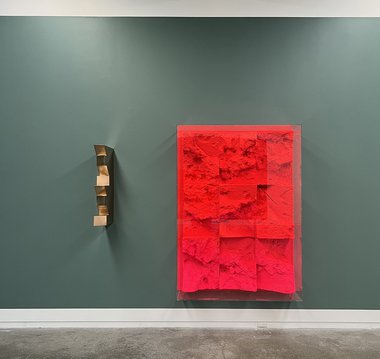




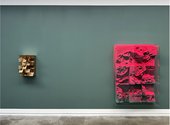
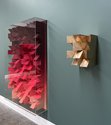



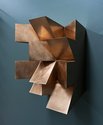

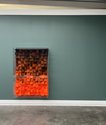
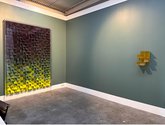

 Advertising in this column
Advertising in this column Two Rooms presents a program of residencies and projects
Two Rooms presents a program of residencies and projects



This Discussion has 0 comments.
Comment
Participate
Register to Participate.
Sign in
Sign in to an existing account.